
The Armitt Museum, also known as the Armitt Museum and Library, is an independent museum and library, founded in Ambleside in Cumbria by Mary Louisa Armitt in 1909. It is a registered charity under English law. [1]

The Armitt Museum, also known as the Armitt Museum and Library, is an independent museum and library, founded in Ambleside in Cumbria by Mary Louisa Armitt in 1909. It is a registered charity under English law. [1]
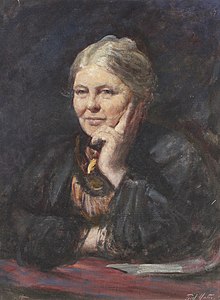
The library was founded by a bequest of Mary Louisa Armitt in order that the intellectual activity of Ambleside could be celebrated. The roots of the organisation go back to the Ambleside Book Society which was founded in 1828 and which formed part of the library. [3] On 8 November 1912 the library opened and Hardwicke Rawnsley who was to co-found the National Trust wrote a poem in celebration. The poem starts:
As in some inland solitude a shell
Still gently whispers of its home, the deep,
So from the world of being beyond all sleep
Where those two happy sister spirits dwell...
The "two happy sister spirits" were Mary Louisa Armitt, who died the year before, and her sister Sophia Armitt. [4]
Beatrix Potter donated books and paintings in her lifetime, and on her death bequeathed her portfolios of natural history watercolours and her personal copies of her "little books". These are on permanent display in an exhibition Beatrix Potter: Image and Reality.
The current building was constructed in 1997 from slate and stone on the land belonging to St Martin's College (formerly Charlotte Mason College). [3]
The Armitt also houses a collection of works by Kurt Schwitters, [2] a German refugee artist who lived and died in Ambleside.
The library of over 11,000 books covers the local and natural history of the Ambleside area and the wider Lake District. [3] It is an important resource for information on notable people connected with the area, including Mary Louisa Armitt, William Wordsworth, Harriet Martineau, John Ruskin, Frederic Yates, [5] Canon Hardwicke Rawnsley and Kurt Schwitters.

Helen Beatrix Heelis, usually known as Beatrix Potter, was an English writer, illustrator, natural scientist, and conservationist. She is best known for her children's books featuring animals, such as The Tale of Peter Rabbit, which was her first commercially published work in 1902. Her books, including 23 Tales, have sold more than 250 million copies. An entrepreneur, Potter was a pioneer of character merchandising. In 1903, Peter Rabbit was the first fictional character to be made into a patented stuffed toy, making him the oldest licensed character.
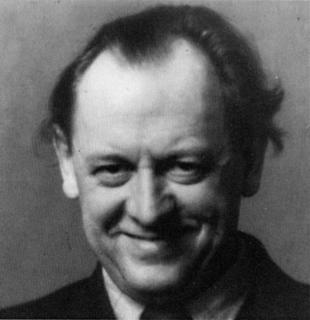
Kurt Hermann Eduard Karl Julius Schwitters was a German artist. He was born in Hanover, Germany, but lived in exile from 1937.
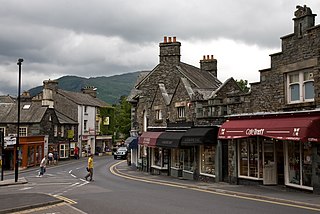
Ambleside is a town and former civil parish in the Westmorland and Furness district of Cumbria, England. Within the boundaries of the historic county of Westmorland and located in the Lake District National Park, the town sits at the head of Windermere, England's largest natural lake. In 2020 it had an estimated population of 2,596.

Grasmere is a village and former civil parish, now in the parish of Lakes, in the Westmorland and Furness district of Cumbria, England, and situated in the centre of the Lake District and named after its adjacent lake. Grasmere lies within the historic county of Westmorland. The Ambleside and Grasmere ward had an estimated population of 4,592 in 2019. William and Dorothy Wordsworth, the 'Lake Poets', lived in Grasmere for 14 years and called it "the loveliest spot that man hath ever found."

Hill Top is a 17th-century house in Near Sawrey near Hawkshead, in the English county of Cumbria. It is an example of Lakeland vernacular architecture with random stone walls and slate roof. The house was once the home of children's author and illustrator Beatrix Potter who left it to the National Trust. It is a Grade II* listed building. It is open to the public as a writer's house museum, shown as Beatrix Potter herself would have known it.

Hardwicke Drummond Rawnsley was an Anglican priest, poet, local politician and conservationist. He became nationally and internationally known as one of the three founders of the National Trust for Places of Historic Interest or Natural Beauty in the 1890s.
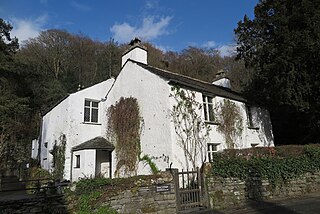
The Wordsworth Trust is an independent charity in the United Kingdom. It celebrates the life of the poet William Wordsworth, and looks after Dove Cottage in the Lake District village of Grasmere where Wordsworth and his sister Dorothy Wordsworth lived between 1799 and 1808. It also looks after the majority of the surrounding properties in the conservation area of Town End, and a collection of manuscripts, books and fine art relating to Wordsworth and other writers and artists of the Romantic period. In 2020 it introduced the brand name Wordsworth Grasmere.
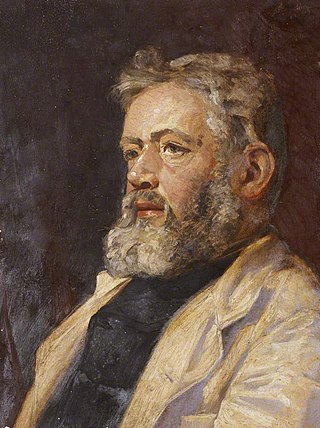
William Gershom Collingwood was an English author, artist, antiquary and professor of Fine Arts at University College, Reading. A long-term resident of Coniston, Cumbria, he was President of the Cumberland and Westmorland Antiquarian Society (1920-32) and the Lake Artists' Society.

Dove Cottage is a house on the edge of Grasmere in the Lake District of England. It is best known as the home of the poet William Wordsworth and his sister Dorothy Wordsworth from December 1799 to May 1808, where they spent over eight years of "plain living, but high thinking". During this period, William wrote much of the poetry for which he is remembered today, including his "Ode: Intimations of Immortality", "Ode to Duty", "My Heart Leaps Up" and "I Wandered Lonely as a Cloud", together with parts of his autobiographical epic, The Prelude.

Wray Castle is a Victorian neo-gothic building at Claife in Cumbria within the boundaries of the historic county of Lancashire. The house and grounds have belonged to the National Trust since 1929, with the house open to the public on a regular basis since 2013. The grounds, which include part of the shoreline of Windermere, are open all year round and are renowned for their selection of specimen trees – Wellingtonia, redwood, Ginkgo biloba, weeping lime and varieties of beech.

Frederic Yates (1854–1919) was an English painter. He painted landscapes and portraits including President Woodrow Wilson and Sanford Ballard Dole, the only president of Hawaii. He settled in the Lake District.

Crosthwaite Parish Church is a church at Great Crosthwaite on the outskirts of Keswick in Cumbria, England. It is dedicated to St Kentigern and is the Anglican church of the parish of Crosthwaite. Since 1951 it has been a Grade II* listed building. The church has an evangelical tradition.

Mary Louisa Armitt was an English polymath. She was a teacher, writer, ornithologist and philanthropist. She was the funder and founder of the Armitt Library, Ambleside.

Sophia Armitt was a British teacher, writer, and naturalist.

Annie Armitt was an English novelist, poet, short story writer, and essayist. She was also one of the founders of a school in Eccles, England.

Allan Bank is a grade II listed two-storey villa standing on high ground slightly to the west of Grasmere village in the heart of the Lake District. It is best known for being from 1808 to 1811 the home of William Wordsworth, but it was also occupied at various times by Dorothy Wordsworth, Dora Wordsworth, Thomas De Quincey, Samuel Taylor Coleridge, Thomas Arnold, Matthew Arnold and Canon Hardwicke Rawnsley, a co-founder of The National Trust. It is now owned by the National Trust and is open to the public.

St Mary's Church is in Ambleside, Cumbria, England. It was built in the 1850s to a design by George Gilbert Scott in Gothic Revival style . The building is Grade II* listed. Notable features include its stone spire, which is a local landmark and an unusual feature in Lake District churches.
Mary Elizabeth Burkett OBE (1924-2014) was an English supporter of the arts, especially in Cumbria, the director of the Abbot Hall Art Gallery from 1966 to 1986, and an expert on felt-making.
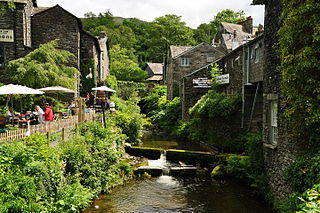
Stock Ghyll, also known as Stock Gill, Stock Gill Beck and Stock Beck, is a stream in South Lakeland, in the ceremonial county of Cumbria and the historic county of Westmorland. It flows about four miles from Red Screes through the town of Ambleside to the River Rothay. Its course includes two long-popular tourist attractions, Stockghyll Force and Bridge House. Stock Ghyll has been painted by J. M. W. Turner, John Ruskin, Kurt Schwitters, and many others. Its name derives from Old English stocc, 'tree-trunk', and Old Norse gil, 'a deep glen'.